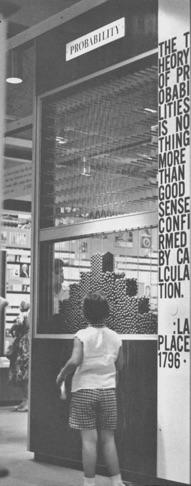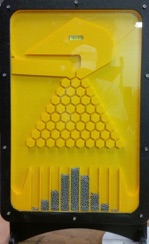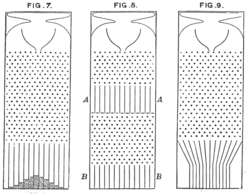Small, lower cost models, perfect for demos, lectures, and classrooms.





If you are looking for a ‘Galton Machine’, you’re in the right place -- we can make you one in just about any size you want!
From Wikipedia,:
The bean machine, as drawn by Sir Francis Galton
The bean machine, also known as the quincunx or Galton box, is a device invented by Sir Francis Galton to demonstrate the central limit theorem, in particular that the normal distribution is approximate to the binomial distribution.
The machine consists of a vertical board with interleaved rows of pins. Balls are dropped from the top, and bounce left and right as they hit the pins. Eventually, they are collected into bins at the bottom. The height of ball columns in the bins approximates a bell curve.
Overlaying Pascal’s Triangle onto the pins shows the number of different paths that can be taken to get to each bin.
http://en.wikipedia.org/wiki/Galton_box

Mixed with 5000 plastic beads is a single golden bead. Kids love to try to predict the path the golden bead will take. There is always a chance that it might fall in one of the 2 end bins; but by the laws of probability theory, which a Galton Machine shows so clearly, it’s so much more likely to fall smack in the middle of the bell curve. That’s what it means to be mediocre!
To help explain how a Galton Machine works, we wrote a computer simulation, shown below, which runs on either Mac OSX or Windows. It makes a great ‘interactive label’ for a real Galton Machine, or can be used by itself. If you would like to play with this software, you can download a free demo copy (not to be used for public display) by clicking the appropriate link:
Dance of Chance for MacOSX.zip


The first ‘Bean Machine’ we ever saw was this lovely and captivating design by Charles and Ray Eames, almost 50 years ago at the New York World’s Fair. Not every exhibit can give visitors life-long insight and inspiration --- but a Galton Machine can!
The Exhibit Guys would so love to make one for your museum!
The motion of each individual ball is random and unpredictable. But the pattern formed at the bottom -- the bell curve -- is inevitable! The bell curve is the foundation of probability theory and statistics.

For an in-depth discussion of the math underlying the Galton Machine, follow this link:
http://mathworld.wolfram.com/GaltonBoard.html


